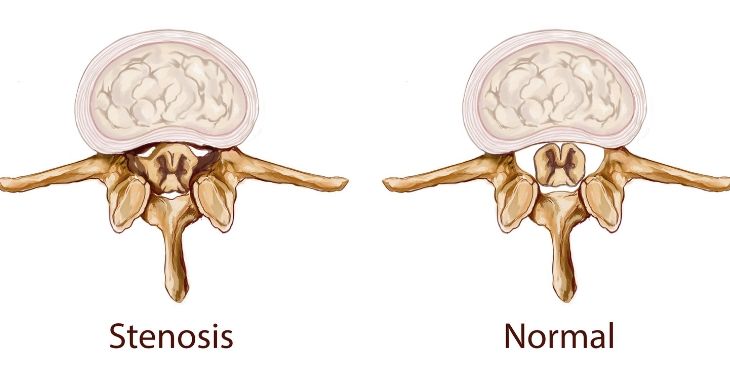Vertiflex Procedure for Lumbar Spinal Stenosis Treatment

One of the most common causes of lower back pain and sciatica is lumbar spinal stenosis. This condition results in a narrowing of the spinal column, which can compress nerves in the lower back. One of the minimally invasive treatment options for lumbar spinal stenosis pain relief is the Vertiflex™ procedure.
Causes and Symptoms of Lumbar Spinal Stenosis
Spinal stenosis can occur in all regions of the spine, but it is most common in the lumbar or lower spine. When the spinal canal narrows in the lumbar region, this is referred to as lumbar spinal stenosis. The spinal canal contains the spinal cord and the nerve roots that exit the spinal column to other areas of the body.
This condition is caused by a variety of issues that can impact the space inside the spinal column. Thickening ligaments around the facet joints of the spine can restrict the spinal canal. Bone spurs, bulging spinal discs, compressed vertebrae and enlarged spinal joints all can contribute to spinal stenosis.
When the spinal canal narrows, the spinal cord and nerve roots can be affected. Nerves can be pinched or compressed, causing localized and radiating symptoms. Since the nerves that exit the lumbar spine affect the lower half of the body, symptoms can radiate downward. Some of the symptoms include:
- Low back pain
- Tingling, numbness or weakness traveling down into the legs
- Radiating pain through the buttocks and legs
- Weakness or numbness in one leg or foot
Spinal stenosis is one of the most common causes of sciatica symptoms. The sciatic nerves exit the lumbar spine and travel down into the right and left legs. Patients with lumbar spinal stenosis usually only have radiating symptoms on one side of the body, not both.
Treatments for lumbar spinal stenosis usually begin with conservative options such as anti-inflammatory medications, physical therapy and pain management. Injection therapy may also be performed. When these treatments are not effective, surgery or minimally invasive options like a Vertiflex implant may be recommended.
What Is a Vertiflex Implant?
When treating lumbar spinal stenosis, the goal is to restore space inside the spinal canal to minimize nerve compression. Decompressing the vertebrae is often required, which has often been accomplished with vertebrae fusion surgery. The Vertiflex implant procedure is a less invasive option for spinal stenosis treatment.
The Vertiflex implant is designed to decompress vertebrae to allow more space where the nerves exit the spinal canal. The device is a spinal spacer that has “wings” that open up to separate vertebrae to create the desired space and relieve pressure on nerve roots.
The Vertiflex procedure is FDA-approved for lumbar spinal stenosis treatment. For many people suffering from spinal stenosis pain, the Vertiflex implant can offer relief from their symptoms without the risks of more invasive spine surgery.
What to Expect During the Vertiflex Procedure
The Vertiflex implant procedure is an outpatient surgery that can quickly offer relief from lumbar spinal stenosis. This is a minimally invasive procedure which can be performed by an orthopedic surgeon or spine specialist. No general anesthesia is needed; patients can remain awake during the surgery.
During the Vertiflex procedure, the area where the implant will be placed is numbed with a local anesthetic. The physician will use imaging to guide where the small incision will be placed, usually only about 1/2-inch long. Instruments are used to move tissue to the side to reveal the spinal column.
Once the targeted vertebrae are exposed, the implant is inserted between the bones. When it is in place, the wings of the Vertiflex implant are opened to spread the vertebrae apart into their correct position. The implant is then secured, and the incision is closed with one suture.
The entire Vertiflex procedure takes about a half an hour for one implant. Some patients may have multiple implants placed to separate compressed vertebrae that are pinching nerves in the lower spine. Patients can go home shortly after their procedure to begin their recovery.
Advantages of Vertiflex
Compared to open spine surgery or a vertebrae fusion, the Vertiflex procedure is much less invasive with few risks. Many patients begin noticing pain relief within a few days after their procedure, although it can require up to six weeks to heal completely. Benefits of Vertiflex include:
- Minimal tissue damage – only the skin is cut, not muscle or other tissue
- Outpatient surgery
- Incision can be covered by a standard bandage
- Quicker recovery
- Patients still have the option of future spine surgery
- Nine out of ten patients in clinical studies were satisfied with their pain relief after the procedure

If you have been diagnosed with lumbar spinal stenosis and want to explore new treatment options, talk to your doctor about the Vertiflex implant procedure. It may be the solution you need to relieve your low back pain and sciatica symptoms.
The information provided on this website, including text, graphics, images, and other materials, is intended solely for informational purposes and should not be used as a substitute for professional medical advice, diagnosis, or treatment.

)